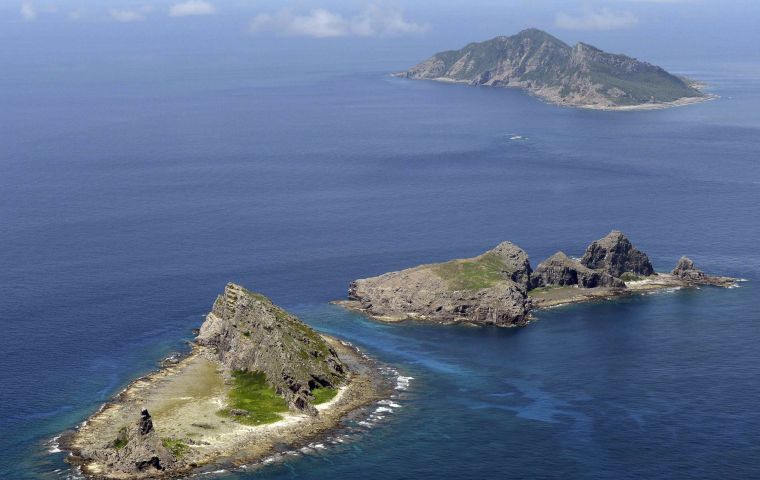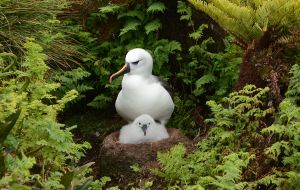MercoPress. South Atlantic News Agency
Tristan albatross threatened by super sized mice in Gough island; an eradication campaign planned for 2020
 Gough Island is a remote UK Overseas Territory, dependency of Tristan da Cunha and part of the BOTof Saint Helena, Ascension and Tristan da Cunha
Gough Island is a remote UK Overseas Territory, dependency of Tristan da Cunha and part of the BOTof Saint Helena, Ascension and Tristan da Cunha  “Many of the seabirds on Gough are small and nest in burrows,” said Dr Anthony Caravaggi, from University College Cork, in the Republic of Ireland
“Many of the seabirds on Gough are small and nest in burrows,” said Dr Anthony Caravaggi, from University College Cork, in the Republic of Ireland Super-sized mice are killing millions of seabird chicks on a remote island in the South Atlantic, threatening some rare species with extinction. According to a study from the RSPB, the mice have learned to eat the eggs and chicks of the many millions of birds that make Gough Island their home.
The group says that without action, the endangered Tristan albatross is likely to go extinct. A campaign is planned to eradicate the mice entirely in 2020.
Gough Island is a remote UK Overseas Territory, a dependency of Tristan da Cunha and part of the British overseas territory of Saint Helena, Ascension and Tristan da Cunha. It is considered to be one of the world's most important seabird colonies, hosting more than 10 million birds.
Mice were introduced to the 91-sq-km volcanic island by sailors during the 19th Century. The rodents have adapted to the limited resources on the small piece of land by developing a taste for seabird eggs and chicks.
Video cameras have recorded groups of up to nine mice eating the chicks alive. As a result of their success, the mice have become “super-sized”. They are about 50% larger than a domestic mouse.
“Many of the seabirds on Gough are small and nest in burrows,” said Dr Anthony Caravaggi, from University College Cork, in the Republic of Ireland.
“The chicks are smaller and have no escape route, so for an opportunistic mouse these chicks constitute relatively easy prey.
”The mice have done so well that they've grown bigger and are now attacking all seabirds, even Tristan albatross chicks, which are far bigger than other, smaller sea-going birds.“
According to Dr Caravaggi's study, at least two million chicks are being lost on an annual basis. The big worries are the rare species on Gough, especially the Tristan albatross. Just 2,000 pairs now remain. The albatrosses mate for life and produce just one egg every other year.
Parents have been recorded returning with food to find their chicks dead in the nest. Their extinction looks certain within a number of decades.
”In a very short space of time, the Tristan albatross will be lost and this is also true for a number of other species,“ said Dr Caravaggi.
”Even though the Tristan is the headline here, a great number of others, including the Atlantic petril and MacGillivray's prion will follow suit if the mice aren't removed.“
Given that the mice have adapted to the opportunity that the seabirds present, why haven't the seabirds also reacted to the threat?
”The fact is that these bird species evolved to live on islands free from predators; that's why you get so many seabirds there,“ said Dr Alex Bond, from the Natural History Museum, another author on the paper.
”For mice there are maybe new generations twice a year, but for birds like the Tristan albatross, they spend their first 10 years out at sea, so it takes a really long time for these behavioral mechanisms to kick in.“
The RSPB, in conjunction with the government of Tristan da Cunha, who are custodians of Gough island, have developed a plan to wipe the mice out completely. The operation is due to take place in 2020. Given the location of the island, it is an enormous logistical challenge.
It involves chartering a ship from South Africa, which will carry two helicopters and a load of poisonous, cereal pellets. These will then be spread across the island by the helicopters. They contain an anticoagulant which should kill the mice within 24 hours.
”Ridding islands of invasive species has been done on around 700 islands worldwide,“ said Dr Bond. ”So this isn't some novel thing we are doing; this is a tried-and-tested technique that can deliver the solution we need.”




Top Comments
Disclaimer & comment rulesCommenting for this story is now closed.
If you have a Facebook account, become a fan and comment on our Facebook Page!